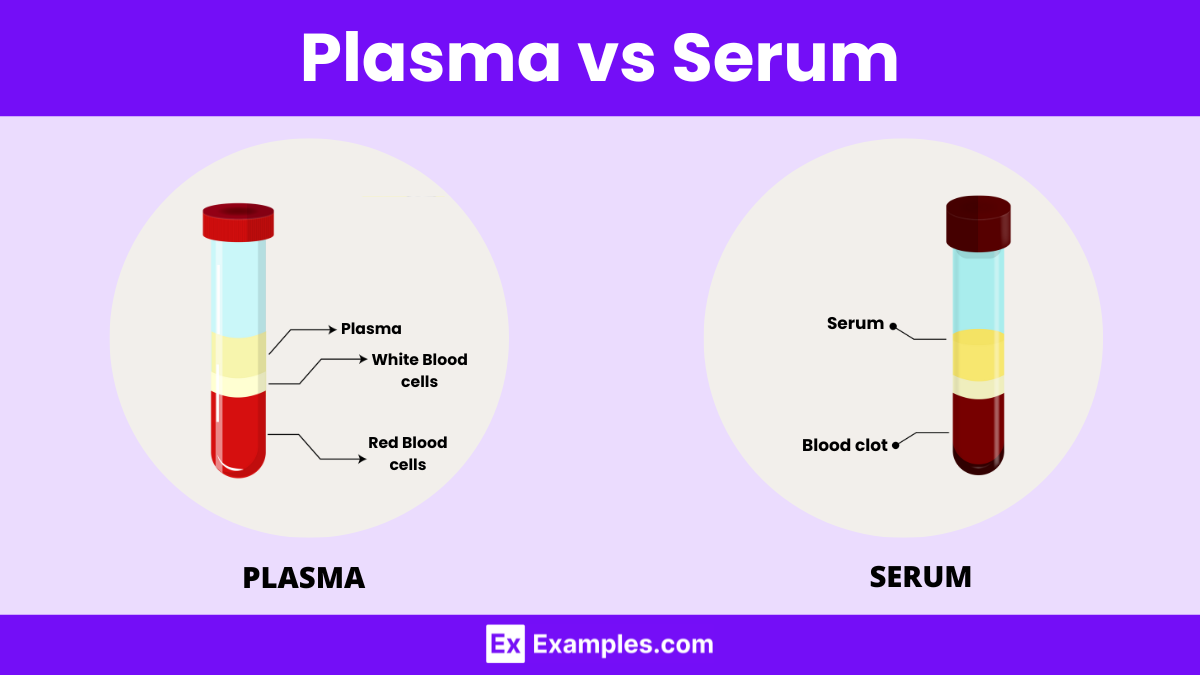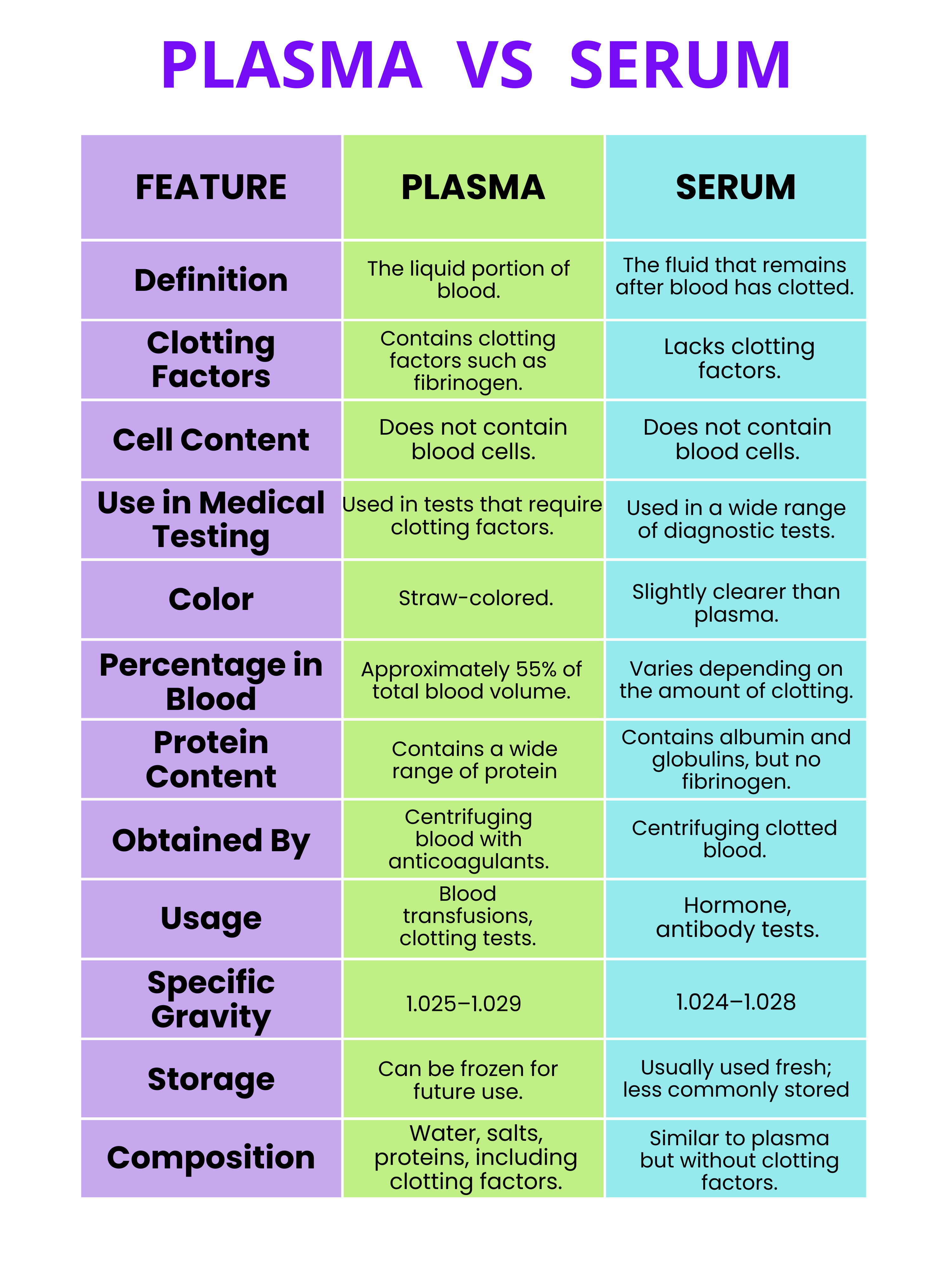What is the main component that differentiates plasma from serum?
Red Blood Cells
White Blood Cells
Fibrinogen
Platelets


Plasma and serum are two fundamental components of blood that play vital roles in the circulatory system of animals, including humans. Both are derived from blood but serve different purposes and have distinct characteristics. Understanding the differences between plasma and serum is crucial for medical science, diagnostics, and research, as each component is used for various tests and procedures. Let’s explore the unique features and functions of plasma and serum, highlighting their importance in health and disease.
Plasma is the liquid portion of blood, comprising about 55% of its volume. It is a straw-colored, watery fluid that carries blood cells, proteins, nutrients, hormones, and waste products throughout the body. Plasma plays a key role in maintaining blood pressure and volume, supplying critical proteins for blood clotting, and supporting immune responses. Serum, on the other hand, is the fluid that remains after the blood has clotted. It is essentially plasma without the clotting factors. Serum contains antibodies, hormones, and other proteins and is used in diagnostic tests to detect diseases and monitor organ function.
Plasma serves as the transport medium for the blood components, facilitating their movement throughout the body. It is akin to a river that carries boats (cells and molecules) to various destinations, ensuring that tissues receive the nutrients, hormones, and proteins they need while removing waste products. Plasma’s composition reflects its diverse roles; it is rich in proteins such as albumin, globulins, and fibrinogen, which are crucial for clotting, immune functions, and maintaining osmotic balance.
Serum is the superhero of diagnostic testing, offering a clear window into the body’s internal environment. After blood coagulation, serum emerges as a clear liquid devoid of cells and clotting proteins, making it ideal for testing as it provides a rich source of antibodies and hormones without the interference of clotting factors. Serum analysis is pivotal in diagnosing diseases, evaluating organ function, and understanding the body’s immune response to infections and vaccines.
Exosome purification from serum and plasma starts with initial centrifugation to separate the liquid components from whole blood. This step is followed by low-speed spins or filtration to remove larger particles. The key step involves high-speed ultracentrifugation, which concentrates the exosomes into a pellet. Additional methods like size-exclusion chromatography may further refine the purity. The final step often includes techniques such as Western blotting to confirm the presence of exosomes in the sample.

| Feature | Plasma | Serum |
|---|---|---|
| Definition | The liquid portion of blood, containing water, proteins, electrolytes, nutrients, and waste products. | The fluid that remains after blood has clotted, devoid of clotting factors. |
| Clotting Factors | Contains clotting factors such as fibrinogen. | Lacks clotting factors. |
| Cell Content | Does not contain blood cells. | Does not contain blood cells. |
| Use in Medical Testing | Used in tests that require clotting factors (e.g., coagulation tests). | Used in a wide range of diagnostic tests, including biochemical and immunological assays. |
| Color | Straw-colored. | Slightly clearer than plasma, due to the absence of clotting proteins. |
| Volume Percentage in Blood | Approximately 55% of total blood volume. | Varies depending on the amount of clotting; usually slightly less than plasma volume. |
| Protein Content | Contains a wide range of proteins, including albumin, globulins, and fibrinogen. | Contains albumin and globulins, but no fibrinogen. |
Plasma contains clotting factors, while serum doesn’t due to clotting. Plasma is the liquid component of blood, whereas serum is plasma without clotting proteins.
Serum is used for certain tests to avoid interference from clotting factors present in plasma. It provides clearer results for specific diagnostic procedures.
Plasma includes clotting factors, while serum does not. Plasma is the liquid portion of blood containing proteins, while serum is plasma without clotting factors.
Both are separated by centrifugation: Plasma is separated by anticoagulant-treated blood, while serum is separated from clotted blood after coagulation and centrifugation.
Yes, by allowing blood to naturally clot and then using manual methods like pipetting or filtration, though less efficient and more time-consuming than centrifugation.
Text prompt
Add Tone
10 Examples of Public speaking
20 Examples of Gas lighting
What is the main component that differentiates plasma from serum?
Red Blood Cells
White Blood Cells
Fibrinogen
Platelets
Which of the following is found in both plasma and serum?
Clotting Factors
Blood Cells
Nutrients
Fibrinogen
Which component is removed from blood to obtain serum?
Platelets
Red Blood Cells
Clotting Factors
White Blood Cells
How is plasma typically separated from blood?
Centrifugation
Filtration
Sedimentation
Coagulation
In a blood sample, which component is the liquid portion before clotting?
Serum
Plasma
Red Blood Cells
Hemoglobin
Which of the following is absent in serum but present in plasma?
Glucose
Albumin
Fibrinogen
Electrolytes
What is the function of fibrinogen in the blood?
Oxygen Transport
Clot Formation
Immune Response
Nutrient Delivery
Which substance would you expect to find at higher levels in plasma compared to serum?
Antibodies
Hormones
Clotting Factors
Enzymes
Which type of blood sample is commonly used for coagulation tests?
Whole Blood
Serum
Plasma
Red Blood Cells
What process is used to obtain serum from blood?
Anticoagulation
Coagulation
Dialysis
Filtration
Before you leave, take our quick quiz to enhance your learning!

